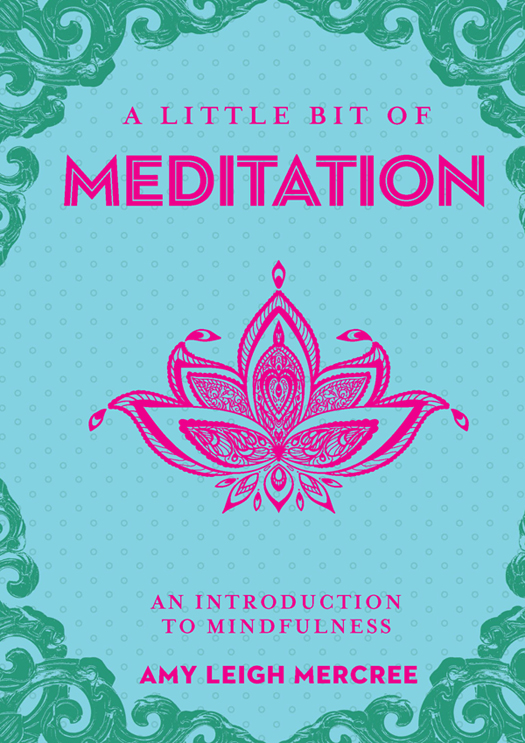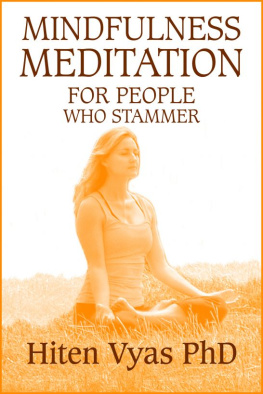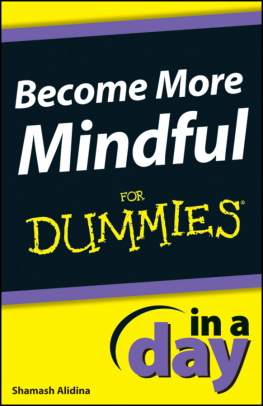Amy Leigh Mercree - A Little Bit of Meditation: An Introduction to Mindfulness
Here you can read online Amy Leigh Mercree - A Little Bit of Meditation: An Introduction to Mindfulness full text of the book (entire story) in english for free. Download pdf and epub, get meaning, cover and reviews about this ebook. year: 2017, genre: Religion. Description of the work, (preface) as well as reviews are available. Best literature library LitArk.com created for fans of good reading and offers a wide selection of genres:
Romance novel
Science fiction
Adventure
Detective
Science
History
Home and family
Prose
Art
Politics
Computer
Non-fiction
Religion
Business
Children
Humor
Choose a favorite category and find really read worthwhile books. Enjoy immersion in the world of imagination, feel the emotions of the characters or learn something new for yourself, make an fascinating discovery.

- Book:A Little Bit of Meditation: An Introduction to Mindfulness
- Author:
- Genre:
- Year:2017
- Rating:5 / 5
- Favourites:Add to favourites
- Your mark:
- 100
- 1
- 2
- 3
- 4
- 5
A Little Bit of Meditation: An Introduction to Mindfulness: summary, description and annotation
We offer to read an annotation, description, summary or preface (depends on what the author of the book "A Little Bit of Meditation: An Introduction to Mindfulness" wrote himself). If you haven't found the necessary information about the book — write in the comments, we will try to find it.
Amy Leigh Mercree: author's other books
Who wrote A Little Bit of Meditation: An Introduction to Mindfulness? Find out the surname, the name of the author of the book and a list of all author's works by series.
A Little Bit of Meditation: An Introduction to Mindfulness — read online for free the complete book (whole text) full work
Below is the text of the book, divided by pages. System saving the place of the last page read, allows you to conveniently read the book "A Little Bit of Meditation: An Introduction to Mindfulness" online for free, without having to search again every time where you left off. Put a bookmark, and you can go to the page where you finished reading at any time.
Font size:
Interval:
Bookmark:



STERLING ETHOS and the distinctive Sterling Ethos logo are registered trademarks of Sterling Publishing Co., Inc.
2017 Amy Leigh Mercree
All rights reserved. No part of this publication may be reproduced, stored in a retrieval system, or transmitted in any form or by any means (including electronic, mechanical, photocopying, recording, or otherwise) without prior written permission from the publisher.
ISBN 978-1-4549-2690-0
For information about custom editions, special sales, and premium and corporate purchases, please contact Sterling Special Sales at 800-805-5489 or specialsales@sterlingpublishing.com.
sterlingpublishing.com
Nowadays in our culture, many roads lead to the art and cultivation of mindfulness. When people seek treatment for anxiety, oftentimes meditation is recommended. When people seek to learn meditation, mindfulness is a result. It is not a new idea that, if we are conscious to and present in the moment we are experiencing at the exclusion of almost everything else, we will be more happy and healthy. Meditation has been used in Eastern religions since ancient times.
The idea of consciousness has been gaining popularity since the 1960s in the Western world. Consciousness is the infinite awareness of being within us all. It is the witnessing part of the self always in the background observing life around you. Meditation, in its many forms, cultivates awareness of consciousness.
In A Little Bit of Meditation, we will explore the history of the practice of meditation and its origins, as well as learn practical applications of how to bring conscious awareness into daily life to improve the quality of our experience on Earth. We will discuss the physical, emotional, mental, and spiritual ramifications of meditating in daily life. A wide variety of practical activities and meditations are included in this volume. So dive in and find your center!


Meditation and mindfulness have become trendy buzzwords in pop culture over the last decade. Meditation practices are no longer relegated to trained practitioners who live in monasteries or ashrams, or adherents to exotic religions and mystical groups. These days, meditation has become a practice that is accessible to almost everyone. It is no longer simply a spiritual tool, either; it has been quickly garnering the backing of neuroscience and other medical specialties because of the health benefits it supplies.
What has sparked the upsurge of interest in meditation? It is thought to have existed for many thousands of years, so why the sudden popularity among diverse groups of people? One answer is the simple fact that the scientific community is giving it credence as a reliable method of stress relief and tool to deal with things such as trauma. Some people believe that the rapidly growing popularity is also due to evolution of consciousness among humanity. Finally, in a world that is increasingly chaotic and moving at a frantic pace, people are seeking out ways to implement calmness and balance in their lives.
The earliest known teachings on meditation came from ancient Hindu religious forms, circa 1500 BCE, from the Vedic texts. This practice of dhyana translates roughly from Sanskrit as contemplation or reflection, and refers to nonjudgmental awareness and sustained attention. This concept was further developed centuries later in Buddhism, Jainism, and formal Hinduism, albeit with slightly different understandings of what it meant.
The internal urge to live a mindful life is not new. In fact, the idea of being present 100 percent of the time has been desirable to some people for thousands of years. Ancient peoples recognized that focusing on one thing at a time could increase productivity and also result in a more pleasurable life.
They worked to cultivate systems and protocols that increase the mind's ability to focus. Aspects of meditation were geared in this direction. In antiquity, this work combined with religious devotion to produce calm, focus, and connection to something larger than one's self.
Meditation can be a doorway to mindfulness. It's interesting how the world's different religions and cultures look to processes of quieting and stilling the mind, and thereby do everything from foster a religious connection to find peace amid stress. These endeavors signify evolution, humanity, and a revolution in understanding consciousness.
Some form of meditation exists in almost every major faith tradition. These largely arose out of the spread of ideas throughout antiquity and increased with broadening travel and trade during the Middle Ages. As groups of people began expanding outward more from their cultural centers, they took their spiritual practices with them. Many scholars believe that meditation practices first appeared in early Vedic teachings, and then developed further in other Asian traditions such as Confucianism, Taoism, and Buddhism.
Meditation forms were present in more than just the major religions of the world. Native American and other indigenous groups had numerous contemplative, meditative, and devotional practices.
Meditation in Hinduism developed out of early Vedic texts, and later, the Upanishads. The earliest forms of meditation were focused on trying to understand ultimate reality. Is the universe a projection of humanity, or is humanity a projection of the universe? Is the universe an illusion, or is our individual existence an illusion?
Scholars of early Hinduism are aware of four types of meditation based on the ancient texts. Rishis were ancient seers or sages who took what they learned from meditation and composed hymns about their conclusions. They wrote of mantra meditation, visual meditation, meditation on learned insights in the heart and mind, and, finally, an ecstatic state that occurs when merging with the universal reality of Brahman (divinity). Early Hinduism also had ascetic adherents who incorporated various other practices such as breath control and the ability to levitate. Similar descriptions of ascetic shaman-seers have been included in modern-day writings like Autobiography of a Yogi by Paramahansa Yogananda.
Hindu meditation developed over the centuries as a multifaceted approach to self-realization called Yoga Vedanta. The yogic path includes components such as service, knowledge, and devotion, and is variable according to each individual's needs. Because Hinduism dates back thousands of years, many schools of thought have risen from it with nuanced differences in belief and practice.
Buddhism developed in India out of early Hinduism. Unlike the yogic eight-limb patheight guidelines to living a meaningful and purposeful life as outlined by the sage PatanjaliBuddhism emphasizes three trainings. Many Americans are most familiar with just the meditation training. However, the other two trainings, wisdom and ethics, are considered to be interconnected with the practice of meditation. Following the death of the Buddha, several doctrinal canons emerged with his supposed teachings. There remains scholarly debate on the authenticity of various portions of these canons, which helped give rise to the different schools of Buddhism.
Font size:
Interval:
Bookmark:
Similar books «A Little Bit of Meditation: An Introduction to Mindfulness»
Look at similar books to A Little Bit of Meditation: An Introduction to Mindfulness. We have selected literature similar in name and meaning in the hope of providing readers with more options to find new, interesting, not yet read works.
Discussion, reviews of the book A Little Bit of Meditation: An Introduction to Mindfulness and just readers' own opinions. Leave your comments, write what you think about the work, its meaning or the main characters. Specify what exactly you liked and what you didn't like, and why you think so.






